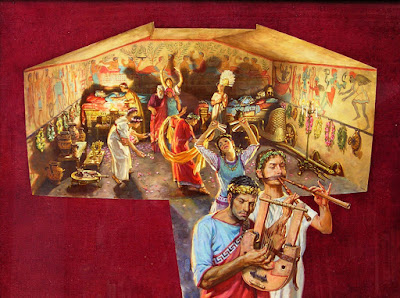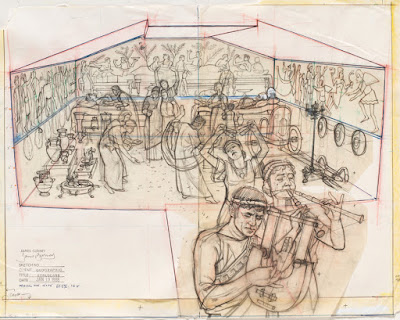In 1987 I traveled on assignment with National Geographic to Italy to explore Etruscan archaeology.
We descended a ladder into the recently discovered "Blue-Devil" tomb in Tarquinia, which unfortunately had been emptied by tomb robbers a little earlier.
The Blue Devil is painted on the wall behind me. He's a blue-skinned dude holding a snake in each hand.

My painting takes us back to around 700BC to show a family departing the tomb, accompanied by musicians and dancers.
The pencil sketch shows the figures as I first imagined them, still without reference to models. The sketch had to be comprehensive enough to sell the editor on setting aside a double page spread in the article layout.
Once we got approval, I asked my friend James Warhola to pose as a musician, holding a cardboard cutout of a lyre. I changed his appearance to look like the story's photographer, Lou Mazzatenta.


For the charcoal comprehensive, I drew each figure grouping on a separate layer of tracing paper. In this way I could experiment with overlapping without erasing or affecting the layers beneath. Of course you could do all this in Photoshop, but working in pencil or charcoal is deliciously tactile and just as fast.
There's more about these methods in my book Imaginative Realism: How to Paint What Doesn’t Exist, available signed from my web store or from Amazon.










3 comments:
Jim, thirty four years later, how might you approach this assignment differently?
You couldn’t do THIS in photoshop. Certainly not in 1987. These process posts are wonderfully informative.
I love your process with the tracing paper! I use photoshop at work but get tired of staring at a computer when I get home, so I'll be using this method to find my composition now. Thanks for sharing.
Post a Comment